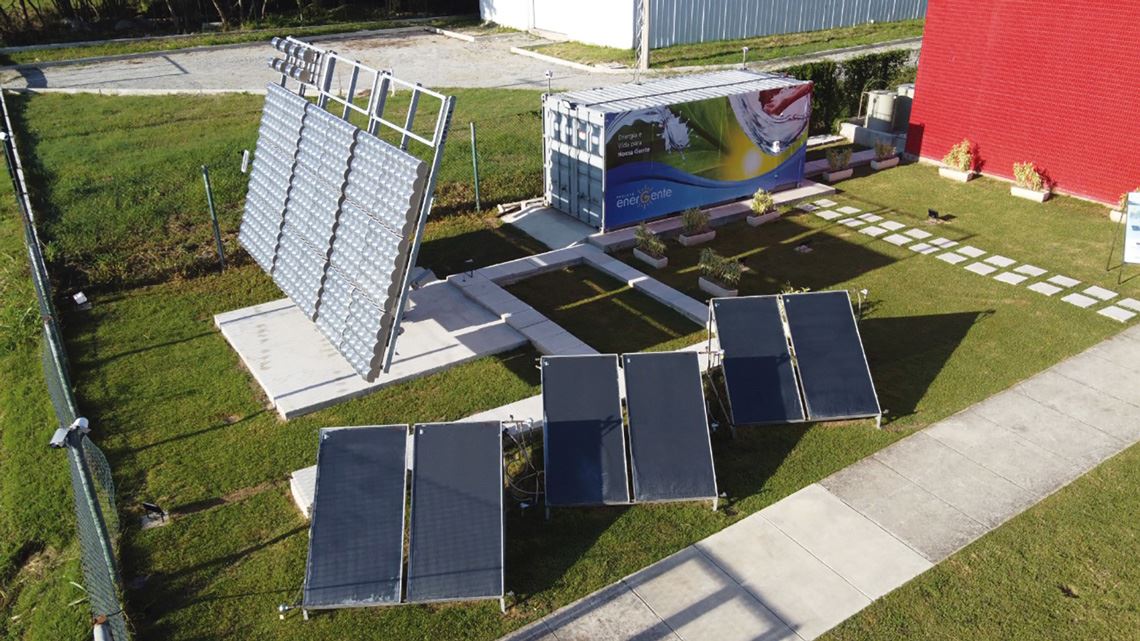A group of 20 Brazilian mechanical, chemical, and mechatronic engineers has created an innovative new system capable of simultaneously generating electricity and distilled water. The team of researchers, all from the Alberto Luiz Coimbra Institute for Engineering Research and Graduate Studies at the Federal University of Rio de Janeiro (COPPE/UFRJ), developed a technology demonstration that recovers the heat wasted by solar panels and reuses it to heat water for a membrane distillation desalinator. This thermal energy can also be used in ambient cooling processes. A prototype was installed at Cidade Universitária, São Paulo, in May this year.
According to Carolina Palma Naveira-Cotta, a professor on COPPE’s Mechanical Engineering program and leader of the project, the system, called Sustainable Polycogeneration Island, could help decentralize electricity production in Brazil, but its objectives go beyond that. “Our idea is to combine the generation of electricity, water, and other inputs. In our prototype, heat is recovered from high-concentration solar panels and used to produce drinking water,” she says.
The technology could potentially be used in locations not connected to the national electricity grid, such as communities in the semiarid Northeast, nearshore oil and gas platforms, islands, conflict zones, and areas suffering from environmental disasters.
The long name given to the system has a simple explanation. “It is called an island because of the possibility of decentralized energy generation, produced in isolation; poly refers to its multiple potential uses; cogeneration describes how the inputs are generated together simultaneously; and it is sustainable because the island’s energy process is self-sustainable,” explains Naveira-Cotta, who manages COPPE’s Nano and Microfluidics and Microsystems Laboratory (LabMEMS).

Coppe / UFRJAerial view of the Sustainable Polycogeneration Island, situated in Cidade Universitária at UFRJCoppe / UFRJ
The demonstration installed at UFRJ occupies an area of 200 square meters (m²) and is equipped with a high-concentration photovoltaic solar panel capable of generating 5 kilowatts (kW) of electrical energy and 8 kW of thermal energy. It also has three sets of solar collectors for complementary water heating. “Some of the energy from solar radiation is lost, dissipating into the environment in the form of heat during the process of converting solar energy into electricity in the panels. Some of the energy that would otherwise be lost is recovered and used in a secondary process,” says the scientist (see infographic).
“The efficiency of commercial solar panels is usually up to around 30%. This means that only a third of the captured solar energy is turned into electricity. The rest is lost in the form of heat,” she says. To recover some of this thermal energy, a system of micro heat exchangers was installed behind the panels. These devices are equipped with microchannels that contain a refrigerant fluid, reclaiming some of the heat that would otherwise be wasted.
“In our demonstration, the recovered heat is used in a secondary water-distillation process that has the potential to produce around 1,000 liters of drinking water per day from salt water,” the researcher explains. This water can be used for human consumption or agro-industrial purposes. “On sunny days, the heat recovered from the panel is enough to warm up the water to be used in desalination,” she says. “The collectors complement the water-heating process on cloudy days.”
João Alves de Lima, a mechanical engineer from the Center for Alternative and Renewable Energies at the Federal University of Paraíba (UFPB), sees COPPE’s initiative as positive and highlights its importance for regions facing water or electricity shortages, but highlights one caveat. “Water production by these thermal processes is still low compared to other desalination technologies,” he says. “However, the methodology proposed by the UFRJ team can be used with much higher salinities than the traditional desalination method of reverse osmosis.”



